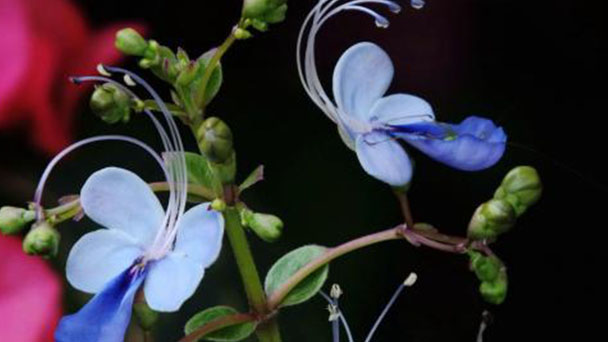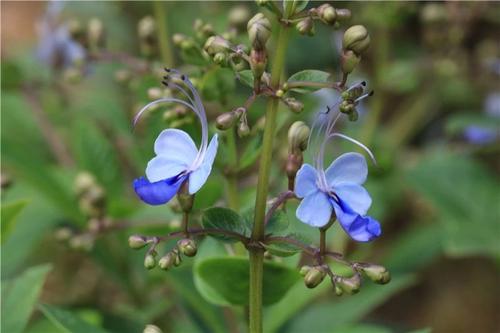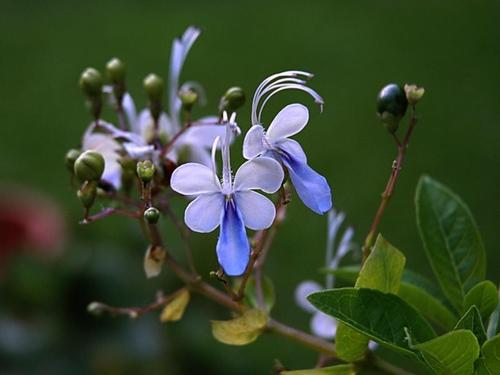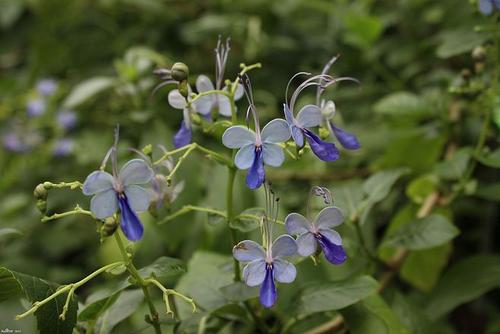Butterfly pea profile
Written by Maggie
Jan 15 2021

Butterfly pea, scientific name Clitoria ternatea, also known as Asian pigeonwings, bluebellvine, blue pea, blossoms very delicately and looks like a butterfly. It is actually a shrub, and many people will be attracted by its beauty.
Butterfly pea picture

Morphological characteristics of Butterfly pea
Stem: Young branches are square, purplish brown. The height is 60cm ~ 1 meter.
Leaves are opposite, obovate to oblateolate, apex acute or obtuse, upper margin shallowly serrate, lower margin entire.
Flowers: Butterfly-like flowers, pale blue to purple, petals flat corolla bilateral symmetry, white corolla, purplish-blue lips, long and slender stamens.
Panicle is terminal. Calyx is 5-lobed, lobes rounded, greenish purple.
Fruit: Fruit is elliptic globose. The diameter is about 0.5~0.8 cm. The surface is punctured.
The growth habits of Butterfly pea
Butterfly pea itself does not have high requirements on soil, generally sandy soil is the best, and it requires good drainage.
Butterfly pea prefers high temperature, so the breeding temperature should be kept between 23 ° C and 32 ° C, and the illumination should be sufficient, even half sunshine and full sunshine. Pay attention to heat preservation in winter.
When breeding Butterfly Pea, it can be pruned appropriately.
Butterfly Pea distribution range
Butterfly Pea is mainly distributed in Uganda, Africa.
Butterfly Pea growing methods
Loam or sandy loam is the best cultivation soil, drainage needs to be good. Butterfly Pea likes high temperature, and the suitable temperature for growth is about 23 ~ 32 degrees C. In winter it needs warm shelter. To adapt to the half-sunshine to a full sunshine environment, the sun will make the leaves more yellow, but does not affect the growth and flowering. In winter, the cold snap can cause a slight dormancy of leaves. In sSpring and summer flowers, inflorescences from branches shoot out, blossoming over quite a long opening period. Dwarfing can be done after flowering to avoid getting taller and thinning. Apply a long - acting fertilizer in late winter and early spring, and replenish it once more after flowering.

Propagation methods of Butterfly Pea
Butterfly Pea is propagated by cutting, spring, autumn as the appropriate period.
Butterfly pea flower language
Butterfly Pea's flower language is, wish to meet you here.
Value of Butterfly Pea
Ornamental value
Butterfly pea has 4 long slender filaments straight forward and curved, purple or white, with ornamental.[1]
Potted flower bed
Butterfly pea can be used as a garden flower or flower bed. Butterfly pea has a long flowering period and is suitable for landscaping or potting.
Nutritional value
Butterfly Pea contains vitamins A,C and E, which can improve immunity, promote skin elasticity and collagen, promote brain vitality, prevent stomach pain, anti-depression, anti-stress, sedation, anticonvulsant, mood relief and other health benefits. The natural blue pigment in Butterfly Pea is also therapeutic. If it is added to lemon and made into scented tea drinks, it is the best drink for heart and blood vessel health.
Edible value
The edible parts of Butterfly Pea are leaves, flowers and tender pods. The tender leaves and blooming flowers can also be used for cooking soup, frying etc. Stir fry shredded meat with tender sprouts or cook to serve. Butterfly pea leaves and flower extracts, can be used as a natural food dye.
Dye value
When Butterfly Pea is boiled in water for five minutes, the pigment in the flowers will fade into the water, and the blue flower water can be used for colored rice, pastries, beverages, and herbal teas.

Latest Updated
- Benefits of Bugleweed - 7 Science-backed Health Benefits
- Bugleweed Dangers & Side Effects - Is It Poisonous?
- How to Plant Evergreen Trees - What You Should Know
- When to Plant Evergreens - Grow Guide for Evergreen Trees
- 12 Wonderful Evergreen Shrubs for Your Garden
- 12 Popular Evergreen Plants with Pictures for Beginners
- When And How To Prune A Lilac Bush Like a Pro
- How to Grow & Care for Lilac Vine (Hardenbergia Violacea)
- Japanese Lilac Tree (Syringa Reticulata) Care & Propagation Guide
- Shumard Oak Pros and Cons - What to Know
Popular Articles
- Winter maintenance of Antirrhinum Majus
- How to Grow Terminalia Mantaly Tree
- How to Grow and Care for Crossostephium Chinense
- How to grow Antirrhinum Majus in spring
- Peristeria Elata (Dove Orchid) Profile: Info & Care Guide
- Underwatered Snake Plant (Sansevieria Trifasciata) - Signs And How To Fix
- How to Care for Brazilian Jasmine Plant (Mandevilla Sanderi)
- How to Grow & Care for Graptopetalum Purple Delight in Summer
- Rosa Chinensis (China Rose): Plant Growing & Care Tips
- How to Care for Baby Sun Rose (Aptenia Cordifolia)